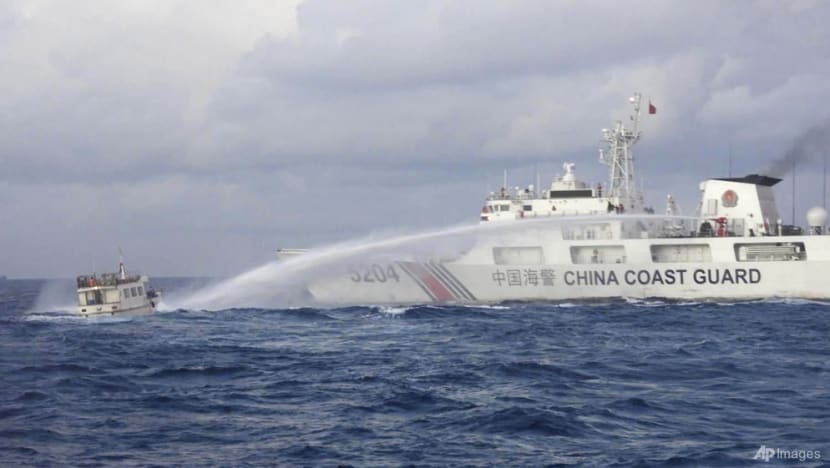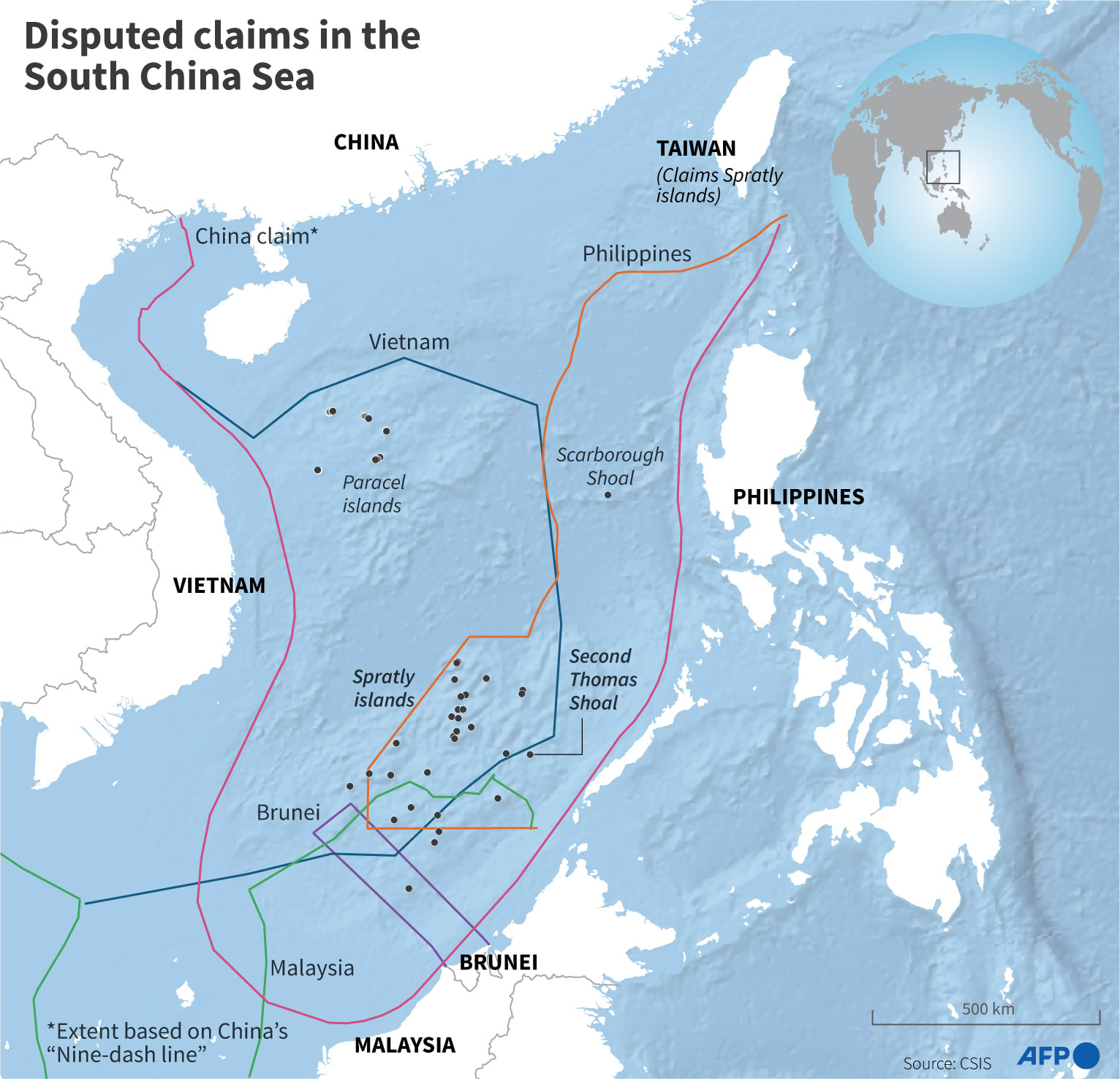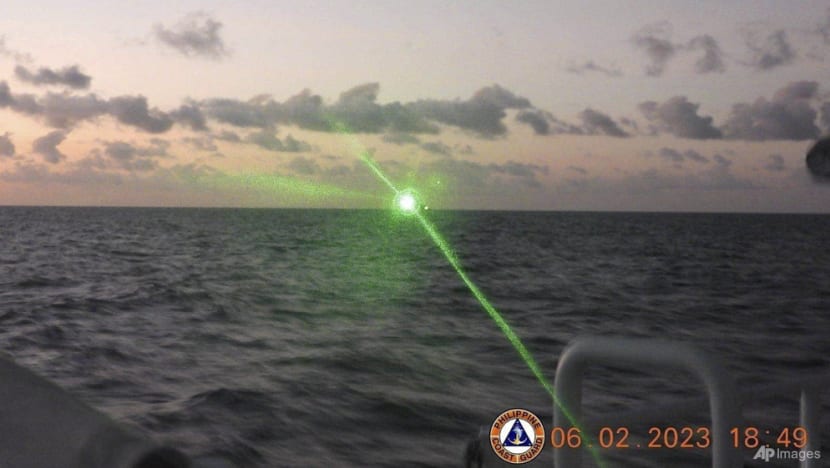CNA Explains: Beijing vs Manila in the South China Sea - what’s the endgame?
After a year of multiple incidents in the key waterway, CNA's Buena Bernal looks at the historical dispute and why Manila's ambassador is warning of the start of another "world war”.

In this handout photo provided by the Philippine Coast Guard, a Chinese Coast Guard ship uses water cannons on Philippine navy-operated supply boat M/L Kalayaan as it approaches Second Thomas Shoal, locally known as Ayungin Shoal, in the disputed South China Sea on Dec 10, 2023. (Photo: AP)

This audio is generated by an AI tool.
MANILA: Unprecedented challenges in the South China Sea merit unprecedented action, Philippine President Ferdinand Marcos Jr said last Saturday (Dec 16).
He was speaking after Philippine officials reported China using water cannons against their vessels at two disputed areas of the sea on two consecutive days.
There have now been four such incidents. And the latest led to the Philippines filing its 64th diplomatic protest against China this year, out of over 130 since Mr Marcos Jr took power in June 2022.
What happened in the South China Sea in 2023?
Some of the incidents reported by the Philippines include:
- The China Coast Guard in February pointing a “military-grade” laser at crew members of a Philippine Coast Guard ship
- More than 100 Chinese fishing or maritime militia vessels “swarming” waters around various disputed reefs, shoals and other features, on at least two separate occasions in June and December
- China installing in September a 300m floating barrier near Scarborough Shoal in waters it claims, which Manila removed saying it was a violation of international law
- Chinese vessels using water cannons in August, November and December on Philippine resupply missions which Beijing said had entered its waters without permission; the clashes also led to other actions which resulted in collisions and damaged boats at least twice
Each episode has been accompanied by a war of words. The Philippines has described China’s “unprovoked acts of coercion” as violating international law, damaging maritime assets and putting lives of Filipino crew at risk.
Beijing has said it’s applying “law enforcement activities” to deal with violations of "indisputable" Chinese sovereignty. This claim relies on what it calls "historic rights" to the South China Sea.
So does the South China Sea belong to China?
Depends on who you ask.
Back in 2009, China unveiled to the United Nations its “nine-dash” line laying claim to over 80 per cent of the South China Sea.
In addition to the Philippines, Southeast Asian countries Vietnam, Malaysia and Brunei also claim parts of the vast ocean, which serves as a crucial maritime route for over US$3 trillion in annual global trade, and as a key source of both fishing and gas reserves.
After a 2012 standoff between the Philippines and China in Scarborough Shoal, Manila took the matter to arbitration in The Hague the next year.
The Philippines wants China to abide by the United Nations Convention on the Law of the Sea or UNCLOS, which sets a country's exclusive economic zone or EEZ at 200 nautical miles from a national landmass.
A historic 2016 arbitral tribunal ruling subsequently found that China’s claim had “no legal basis". Beijing squarely rejected this as “null and void”.

For more context, we have to go back another decade - to 2002, when China and members of the Association for Southeast Asian Nations (ASEAN) signed a non-binding declaration committing to not inhabit or develop uninhabited features in the South China Sea.
Yet in 2007 Beijing began deploying maritime forces and establishing military bases in the disputed Spratly Islands archipelago, according to lawyer Jay Batongbacal, director of the Institute for Maritime Affairs and Law of the Sea at the University of the Philippines.
In December 2022, Western media reports said China was undertaking fresh reclamation projects in the South China Sea - allegations rejected by Beijing.
Geopolitical analyst Don McLain Gill described China's signing of the 2002 declaration as a gesture to project itself as a good neighbour and to foster "a conducive environment” for its growth.
The 2002 statement had all parties agreeing to work towards a code of conduct to set norms in the waterway. This is still being negotiated today, with most recent reports indicating a three-year deadline to complete talks.
"China ... finds it unnecessary, really, to go forward with such a code of conduct that may restrain its future ambitions,” Mr Gill told CNA. “It has been able to shift the regional balance of power to its favour.”
Have China and the Philippines tried to work it out?
Weeks before the February laser-pointing incident, Mr Marcos Jr paid a state visit to China - his first to a country outside of Southeast Asia - where he and counterpart Xi Jinping agreed on a direct communication line to handle maritime disputes.
But this, according to a high-ranking Philippine official, has had "rather limited" usefulness.
Mr Marcos last Saturday also said "traditional methods of diplomacy" with China over the years had yielded "very little progress".
In response, Beijing on Tuesday said maritime disputes did "not represent the entirety of China-Philippine relations".
"We stand ready to properly handle disputes through dialogue and consultation," said foreign ministry spokesperson Wang Wenbin. "(We) will not close our door of dialogue and contact with the Philippines."
Mr Marcos Jr represents for China a markedly different proposition from his predecessor Rodrigo Duterte.
The latter once tagged the 2016 arbitral ruling as a piece of paper that could be thrown in the trash. He also attempted to abrogate a Visiting Forces Agreement which sets rules for rotating US troops into and out of the Philippines.
In contrast, Mr Marcos Jr has repeatedly vowed not to give up a single inch of territory, and expanded a defence deal to grant the US access to key Philippine military bases.
He has also committed to more trilateral cooperation with US allies. To date, the Philippines has also conducted joint maritime drills with Australia and Japan in the South China Sea.
These countries have in turn backed Manila throughout its altercations with Beijing.

Independent analyst Andrea Chloe Wong said the Marcos administration was attempting to mitigate the Philippines’ limited defence capabilities. But she warned that bilateral relations may be put at risk if Beijing views Manila as aligning more towards the West.
After the US criticised China over its most recent incident in the South China Sea, a foreign ministry spokesperson replied that Washington had “for some time been conniving at, emboldening and supporting the Philippines’ infringement and provocation” in the waterway.
Beijing had previously voiced disapproval over Manila allowing American forces use of its bases - one of which lies near the South China Sea - and accused the US of sowing tensions in the region.
Could all of this bubble over to something serious?
Rhetorical fears and warnings that the South China Sea might go the way of Russia-Ukraine and Israel-Hamas have emerged in recent weeks.
One American magazine called it “the most dangerous conflict no one is talking about”.
The Philippine ambassador to the US also told Japan’s Nikkei that the waterway, not Taiwan, was “the flashpoint”; and that maritime friction there is akin to “the beginning of another war, world war”.
Mr Duterte also repeatedly disclosed in speeches that Mr Xi had warned of "trouble" if the Philippines drilled oil in areas of the sea claimed by China.
The US has vowed to come to Manila’s aid should maritime assets within its territory come under attack. A mutual defence treaty between the two considers an attack on one as an attack on the other.
Observers have suggested that Mr Xi might want to test the US' commitment to its allies, as part of his strategy for the South China Sea.
But full-blown conflict is not likely to break out soon there, according to Mr Ray Powell, a project lead at Stanford University's Gordian Knot Center for National Security Innovation.
"I don’t believe there is an appetite for war on any side of this situation,” he told CNA.
“I think we are into an extended cycle of gradual, minor escalations as Manila pushes to fully expose the extent of PRC (People's Republic of China) aggression and Beijing feels compelled to make an example of it.”
The Philippines has made a point to publicise developments in the disputed waters, including by frequently inviting reporters onto vessels.
Mr Powell described this as "assertive transparency" meant to counter China’s grey-zone tactics, which fall short of the threshold for acts of war but are aggressive enough to disadvantage weaker states.
Going by Mr Marcos Jr's recent comments - and show of frustration - the diplomatic route may no longer cut it.
Yet the president has also taken off the table the option of expelling Beijing's envoy to the Philippines. For now, Manila is likely to continue formulating non-violent solutions to the repeated tense encounters at sea.
An interagency team of lawyers, for instance, has been formed to explore a fresh suit alleging "illegal harassment" by China.
"We have to come up with a new concept, a new principle, a new idea, so that we move, as I say, we move the needle the other way," said Mr Marcos Jr.
"We have to come up with a paradigm shift."

















